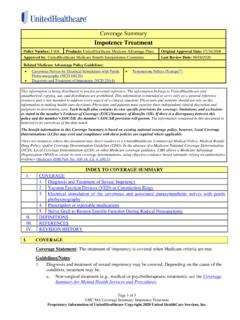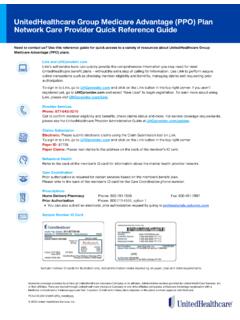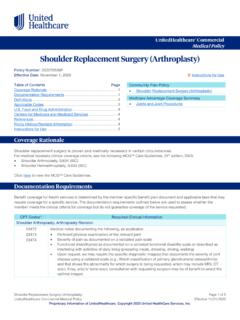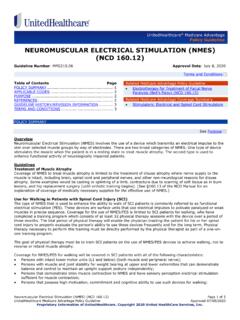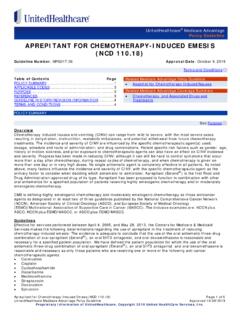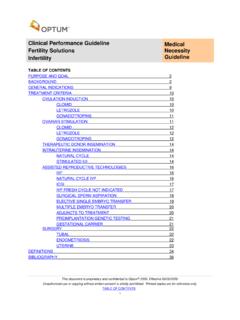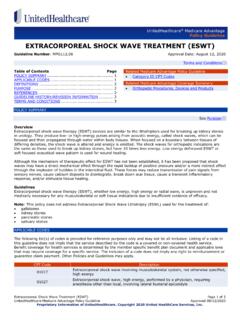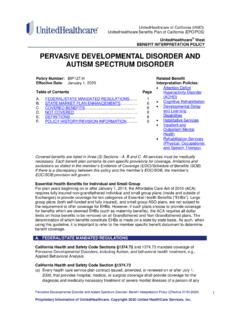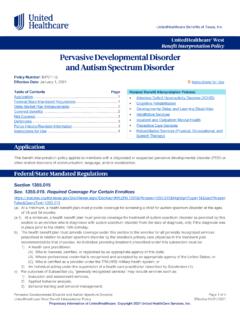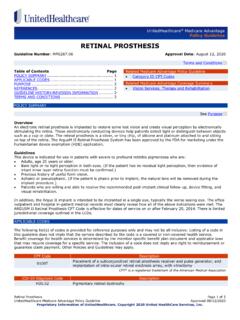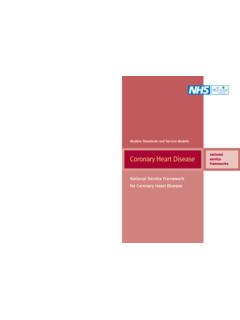Transcription of Percutaneous Coronary Interventions - UHCprovider.com
1 Percutaneous Coronary Interventions Page 1 of 9 UnitedHealthcare Medicare Advantage Policy Guideline Approved 03/11/2020 Proprietary Information of UnitedHealthcare. Copyright 2020 United HealthCare Services, Inc. Percutaneous Coronary Interventions Guideline Number: Approval Date: March 11, 2020 Table of Contents Page POLICY SUMMARY .. 1 APPLICABLE CODES .. 2 PURPOSE .. 7 REFERENCES .. 7 GUIDELINE HISTORY/REVISION INFORMATION .. 8 TERMS AND CONDITIONS .. 9 POLICY SUMMARY Overview Percutaneous Coronary intervention (PCI), commonly known as Coronary angioplasty or simply angioplasty, is a non-surgical procedure used to treat the stenotic (narrowed) Coronary arteries of the heart found in Coronary heart disease .
2 These stenotic segments are due to the buildup of the cholesterol-laden plaques that form due to atherosclerosis. During PCI, a cardiologist feeds a deflated balloon or other device on a catheter from the inguinal femoral artery or radial artery up through blood vessels until they reach the site of blockage in the heart. X-ray imaging is used to guide the catheter threading. At the blockage, the balloon is inflated to open the artery, allowing blood to flow. A stent is often placed at the site of blockage to permanently open the artery. Percutaneous transluminal Coronary angioplasty (PTCA) is a minimally invasive procedure to open up blocked Coronary arteries, allowing blood to circulate unobstructed to the heart muscle.
3 Guidelines Percutaneous Coronary intervention (PCI) may be indicated in the management of: Patients with acute Coronary syndrome ( , acute myocardial infarction, unstable angina) Patients with a history of significant obstructive atherosclerotic disease Patients with restenosis of a Coronary artery previously treated with intracoronary stent or other revascularization procedure Patients with chronic angina Patients with silent ischemia Generally PCI is not indicated for: Patients that can be managed medically Right heart catheterization and insertion of a Swan-Ganz catheter are not generally medically necessary for a PCI and will be denied, unless medically necessary when performed incident to a diagnostic catheterization prior to the intervention Standby services of a surgeon or anesthesiologist are not covered services Patients with stable Coronary artery disease (CAD) Related Medicare Advantage Policy Guideline Percutaneous Transluminal Angioplasty (PTA) (NCD ) Ultrasound Diagnostic Procedures (NCD )
4 Related Medicare Advantage Reimbursement Policies Multiple Procedure Payment Reduction (MPPR) on Diagnostic Cardiovascular and Ophthalmology Procedures Policy, Professional Multiple Procedure Payment Reduction (MPPR) for Medical and Surgical Services Policy, Professional Assistant-at-Surgery Services Policy, Professional Related Medicare Advantage Coverage Summaries Cardiovascular Diagnostic Procedures Percutaneous Transluminal Angioplasty and Stenting UnitedHealthcare Medicare Advantage Policy Guideline Terms and Conditions See Purpose Percutaneous Coronary Interventions Page 2 of 9 UnitedHealthcare Medicare Advantage Policy Guideline Approved 03/11/2020 Proprietary Information of UnitedHealthcare.
5 Copyright 2020 United HealthCare Services, Inc. Indications for Intracoronary Ultrasound and Doppler Fractional Flow Reserve Studies Intracoronary ultrasound may be separately covered when needed to assess the extent of Coronary stenosis if equivocal on angiography, or when needed to assess the patency and integrity of a Coronary artery post-intervention. Alternatively, intravascular doppler velocity and/or pressure derived Coronary flow reserve measurement may be performed to assess the degree of stenosis within a vessel. Intracoronary ultrasound or fractional flow reserve measurement should be performed on an individual artery as clinically indicated.
6 Both procedures are not considered medically necessary unless written documentation in the form of a procedure note is submitted to support medical necessity. Intracoronary ultrasound and doppler fractional flow reserve studies can be required in multivessel CAD. Modifier Claims for Percutaneous Coronary intervention must include the appropriate modifiers to identify which vessel is undergoing a specific procedure. Modifiers are identified as: LD (left anterior descending Coronary artery), LC (left circumflex Coronary artery), RC (right Coronary artery), LM (left main artery) and RI (rasmus intermedius artery).
7 APPLICABLE CODES The following list(s) of codes is provided for reference purposes only and may not be all inclusive. Listing of a code in this guideline does not imply that the service described by the code is a covered or non-covered health service. Benefit coverage for health services is determined by the member specific benefit plan document and applicable laws that may require coverage for a specific service. The inclusion of a code does not imply any right to reimbursement or guarantee claim payment. Other Policies and Guidelines may apply. CPT Code Description 92920 Percutaneous transluminal Coronary angioplasty; single major Coronary artery or branch 92921 Percutaneous transluminal Coronary angioplasty; each additional branch of a major Coronary artery (List separately in addition to code for primary procedure) (bundled code and will not be separately reimbursed) 92924 Percutaneous transluminal Coronary atherectomy, with Coronary angioplasty when performed; single major Coronary artery or branch 92925 Percutaneous transluminal Coronary atherectomy, with Coronary angioplasty when performed.
8 Each additional branch of a major Coronary artery (List separately in addition to code for primary procedure) (bundled code and will not be separately reimbursed) 92928 Percutaneous transcatheter placement of intracoronary stent(s), with Coronary angioplasty when performed; single major Coronary artery or branch 92929 Percutaneous transcatheter placement of intracoronary stent(s), with Coronary angioplasty when performed; each additional branch of a major Coronary artery (List separately in addition to code for primary procedure) (bundled code and will not be separately reimbursed) 92933 Percutaneous transluminal Coronary atherectomy, with intracoronary stent, with Coronary angioplasty when performed; single major Coronary artery or branch 92934 Percutaneous transluminal Coronary atherectomy, with intracoronary stent, with Coronary angioplasty when performed.
9 Each additional branch of a major Coronary artery (List separately in addition to code for primary procedure) (bundled code and will not be separately reimbursed) 92937 Percutaneous transluminal revascularization of or through Coronary artery bypass graft (internal mammary, free arterial, venous), any combination of intracoronary stent, atherectomy and angioplasty, including distal protection when performed; single vessel 92938 Percutaneous transluminal revascularization of or through Coronary artery bypass graft (internal mammary, free arterial, venous), any combination of intracoronary stent, atherectomy and angioplasty, including distal protection when performed.
10 Each additional branch subtended by the bypass graft (List separately in addition to code for primary procedure) (bundled code and will not be separately reimbursed) 92941 Percutaneous transluminal revascularization of acute total/subtotal occlusion during acute myocardial infarction, Coronary artery or Coronary artery bypass graft, any combination of intracoronary stent, atherectomy and angioplasty, including aspiration thrombectomy when performed, single vessel Percutaneous Coronary Interventions Page 3 of 9 UnitedHealthcare Medicare Advantage Policy Guideline Approved 03/11/2020 Proprietary Information of UnitedHealthcare.
